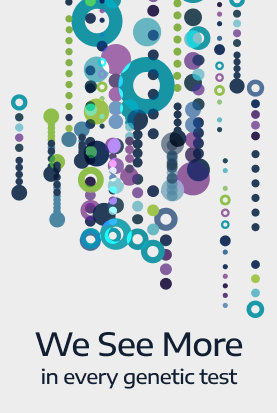Repeat Expansions Analyzed

Our whole genome platform detects the characterized repeats listed below.
All of the listed repeats are analyzed by the following comprehensive analyses:
- Genomic Unity® 2.0
- Genomic Unity® Whole Genome Analysis
- Genomic Unity® Exome Plus Analysis
- Genomic Unity® Exome Analysis.
Some of the listed repeats are analyzed by our Neurology Analyses and/or Other Targeted Analyses. The relevant tests are noted in the following table. Follow the gene links for detailed information about reporting ranges.
Genomic Unity® 2.0 analyzes additional repeats not available in other tests. The additional repeats are listed in a second, separate table.
Gene(s) | Repeat | Disorder | Neurology Analyses and/or Other Targeted Analyses That Include This STR* |
CCG | Fragile XE syndrome | ||
CAG | Spinal and bulbar muscular atrophy | ||
CGC | X-linked Intellectual developmental disorder 29 and Partington syndrome | ||
CAG | Dentatorubral-pallidoluysian atrophy (DRPLA) | ||
ATXN1** | CAG | Spinocerebellar ataxia 1 (SCA1) | |
ATTCT | Spinocerebellar ataxia 10 (SCA10) | ||
CAG | Spinocerebellar ataxia 2 (SCA2) | ||
CAG | Spinocerebellar ataxia 3 (SCA3) | ||
CAG | Spinocerebellar ataxia 7 (SCA7) | ||
CTG | Spinocerebellar ataxia 8 (SCA8) | ||
C9orf72** | GGGGCC | Frontotemporal dementia and/or amyotrophic lateral sclerosis (FTDALS1) | |
CACNA1A** | CAG | Spinocerebellar ataxia 6 (SCA6) | |
CNBP** | CCTG | Myotonic dystrophy type II | |
CCCCGCCCCGCG | Myoclonus epilepsy | ||
CGG | FRA12A fragile site | ||
CTG | Myotonic dystrophy type I | ||
FGF14** | GAA | Late-onset spinocerebellar ataxia 27B (SCA27B) | |
CGG | Fragile X syndrome | ||
GCN | Blepharophimosis, ptosis, and epicanthus inversus syndrome type II (BPES II) | See comprehensive analyses above | |
GAA | Friedreich’s ataxia | ||
GGC | Oculopharyngodistal myopathy 2 (OPDM2) | ||
GCA | Global developmental delay, progressive ataxia, and elevated glutamine (GDPAG) | ||
CAG | Huntington disease | ||
CTG | Huntington disease-like 2 syndrome | ||
CGG | Oculopharyngodistal myopathy 1 (OPDM1) | ||
NOP56** | GGCCTG | Spinocerebellar ataxia 36 (SCA36) | |
GGC | Neuronal intranuclear inclusion disease | ||
PABPN1** | GCN | Oculopharyngeal muscular dystrophy (OPMD) | See comprehensive analyses above |
Alanine | Congenital central hypoventilation syndrome | See comprehensive analyses above | |
CAG | Spinocerebellar ataxia 12 (SCA12) | ||
RFC1** | AAGGG and other pathogenic repeats | Cerebellar ataxia, neuropathy, and vestibular areflexia syndrome (CANVAS) | |
GCN | X linked intellectual developmental disorder with isolated growth hormone deficiency X linked panhypopituitarism | See comprehensive analyses above | |
Glutamine | Spinocerebellar ataxia 17 (SCA17) | ||
TCF4** | CAG | Fuchs endothelial corneal dystrophy | See comprehensive analyses above |
GGCGCGGAGC | Hereditary distal motor neuropathy with myopathic features (HMNMYO) | ||
GGC | Spinocerebellar ataxia 4 (SCA4) | ||
GCN | Holoprosencephaly 5 | See comprehensive analyses above |
Please note: Genomic Unity® Lightning Genome Analysis and IriSight® Comprehensive Analysis – Prenatal are not addressed in this table. Please see the relevant test page for more information about repeats analyzed by these tests.
*ARX repeat expansions will be reported only in cases where the clinical symptoms of the patient include early-onset seizures.
**As the disorders are typically adult onset, repeat expansions in these genes are not reported in minors in comprehensive analyses.
Additional repeats analyzed by Genomic Unity® 2.0
Gene(s) | Repeat | Disorder | Analyses That Include This STR |
BEAN1** | TGGAA | Spinocerebellar ataxia 31 (SCA31) | |
GCN | Hand-foot-genital syndrome (HFGS) | ||
GCC | Hereditary sensory and autonomic neuropathy type VIII (HSAN8) | ||
PRNP** | 24-base octapeptide PHGGGWGQ | Prion diseases | |
RILPL1** | CGG | Oculopharyngodistal myopathy type 4 (OPDM4) | |
CAG followed by GCN | Cleidocranial dysplasia (CCD) | ||
(TTTTA)₇TTA (TTTTA)₁₃ | Benign adult familial myoclonic epilepsy (BAFME) |
**As the disorders are typically adult onset, repeat expansions in these genes are not reported in minors in comprehensive analyses.
